
Vol. 1, No. 5 NEWS PUBLICATION OF THE XX BOMBER COMMAND 5 MARCH 1945

|
|
Stage First Big Scale Raid on Japs By SUPER-FORT Writer Japan, long protected by its geographical location, is now getting a bitter taste of the bombing potentiality of the American military machine - of the 1,500 plane raids that soon will be as common as the everyday "milk runs" over Germany. Within the last two weeks Tokyo, third largest city in the world, has been the target of combined Army-Navy operations. The sprawling Japanese capital had been bombed before, nearly a dozen times, but never in the same proportion and with the same ferocity as the surprise raid of Feb. 16 and 17, and the follow-ups of Feb. 19 and Feb. 25. A task force under Vice Adm. Marc A. Mitacher steamed boldly into the Japanese home waters on Feb. 16 and launched a 1,200-plane attack - the likes of which the Japanese had never seen before. For two days the force lay off Honshu, and hammered at Tokyo and its environs in full strength. In place of Superfortresses from the XXI Bomber Command that have been bombing the city since last November, swarms of carrier-based planes struck at treetop level, hitting airfields, aircraft and other military targets around the city in strafing attack. The raid was a full-scale, planned offensive. Fighter opposition was swept from the sky by the Navy attackers, which destroyed or damaged 659 Jap planes and 36 ships, including an escort carrier and three other warships. Three days after the initial Navy attack, a large force of Maj. Gen. Curtis E. LeMay's B-29s dropped "heavies" on the city's military installations. Then, on Feb. 25, came the double attack. More than 200 Superfortresses of the XXI Bomber Command hit the industrial targets in the Tokyo area. The Navy sent some 1,600 planes, in waves of 200 and 250, against the military installation of metropolitan Tokyo area, according to a Japanese radio report picked up in New York. More than 2,000 tons of bombs were dropped during the raid. Though the two large-scale raids resulted in tremendous damage and definitely hurt the Nips' war machine, they were just the beginning. Gen. Hap Arnold has stated that the Japanese homeland would be pounded again and again until the war is over. The Americans now have the range. |
|
Japs Couldn't Down
"Last Resort"
By SUPER-FORT Writer
APO 631 (Chakulia, India) - Maj. Donald W. Roberts now has a Silver Star, awarded for "gallantry in action," but he won't need a medal to remember the Last Resort - his Jap-defying Superfort.
"She was a great girl," he beamed when the name of his former plane was mentioned. "Wanna see her?"
Though he had just returned from a mercy mission into Burma, was without sleep for nearly four days, and had a thick growth of beard, Maj. Roberts jumped into a Jeep and headed for the base salvage yard.
"There she is," he pointed as the guard was opening the gate. The nose, bearing the painted Indian woman and the faded name - Last Resort - was all that was left. Walking up to the remaining part of his once-proud plane, he defensively emphasized:
"The Japs didn't put her here. They couldn't. She was caught in the explosion (one B-29 exploded here Jan. 14 and corrugated the fuselage of the Last Resort so badly it had to be salvaged.)
Explaining that the Last Resort was short-lived, had only gone on nine missions - all piloted by
|
 St. Pats Day Memo
St. Pats Day MemoNot that anyone gives a damn, but St. Patrick's Day is only a few days away as the costume of June Haver, 20th Century Fox star of "Irish Eyes Are Smiling" indicates. She has blonde hair (as you can see), blue eyes (which you could see if this were Technicolor), is 18, and Life magazine says: "sings with a fresh voice." |
"The Japs just couldn't down her," he continued, adding that the Last Resort was "shot up four times within a period of one month."
On the Omura mission of Nov. 21, for which he was awarded the Silver Star, Maj. Roberts said the Japs really gave his girl hell. Fighters swarmed about the B-29, riddling it with tracers. Two engines were knocked out and a third was badly damaged.
"But the Last Resort kept going," he proudly said, "blazing hot lead all about the sky. We knocked Jap fighters all over, but only saw a couple actually crash." (Official XX Bomber Command reports revealed that three enemy fighters were destroyed, two were probably destroyed and others were damaged.)
Though attacked enroute to the target, the Last Resort successfully dropped its bomb load with good results, and - in a running fight - slugged its way to a Command base.
"That plane couldn't be downed by the Japs," he repeated walking back to his Jeep. "If you want to hear more about her, drop in again. I got to get some sleep now."
All of Maj. Robert's crew were awarded the Distinguished Flying Cross for their meritorious work on the Omura mission. And, incidentally, their new plane will - in all probability - be named the Last Resort, Jr.
|
By SUPER-FORT Writer
APO 220 (Piardoba) - Col. Alfred F. Kalberer is a soft-spoken FLYER of dynamic energy, a Commanding Officer who takes great pride in his Superfortress Bomb Group and a leader respected by all his men as "Number One Hellbird."
He has a sincere love for everything aeronautical, even to the tune of penning out articles for publications. His by-line appeared frequently before his last enlistment in the Army and has appeared since on special assignments.
A veteran of the old school, the Flying Jenny, Col. Kalberer abandoned a medical career to attend flying school at Brooks and Kelly Fields in Texas. Gen. Claire Chennault, then a lieutenant, was one of his instructors. After graduation, he became a member of the First Pursuit Squadron, piloting the old Curtis Hawk.
Bored with peacetime Army flying, Col. Kalberer went on inactive status and really began piercing the clouds. He made the first aerial advertising tour throughout the U.S., Canada and Mexico, flew the mails for National Air Transportation, and later flew the longest run in the world, from Europe to the East Indies, as pilot for the KLM (Royal Dutch Air Lines.)
A wide traveler, Col. Kalberer had visited the Reich many times prior to war and had noticed the growth of the German military machine. When the Nazis broke loose, he had to step lively to keep ahead of them. Just before resigning his job with the east Indian division of the Dutch Air Lines, the colonel was warned by a Nipponese pilot friend of the approaching war between the U.S. and Japan. He was skeptical, but left from Manila by clipper late in November of 1941.
War was declared while he was driving across country. Immediately he returned to active duty as a 1st Lieutenant.
As a Ferry Command pilot, he spent the first 30 days of the war analyzing and writing a book covering the terrain, weather, radio aids, etc. in all countries between Alexandria, Egypt, to Sydney, Australia.
Then he joined Col. Halverson's Group of B-24s, the bombers that started on a special mission to China but . . . when halfway around the world, slowed down to smash at the Ploesti Oil Fields on orders from Washington. This mark fsed the first real American attack on Europe and out of 13 planes, only four returned to the original base. Five were forced to land in Turkey.
One of the fortunate flyers, Col. Kalberer came through the initial attack unscratched, almost immediately led a small force of Liberators and Beaufighters in an attack on the Italian fleet. They sank a cruiser and damaged two battleships. The rest of the fleet scurried into the harbor of Torrento, where it stayed until the surrender.
After that and a few more important missions, the Colonel could have retired to a desk job. However, rumor of the B-29 began to spread. When the Superfortress became fact, he found himself in India with the XX Bomber Command.
|
By SUPER-FORT Writer
APO 215 (Charra and Dudhkundi) - There's no more bitching in the "Lucky 7" mess hall - not since S/Sgt. Emile Manara began fathering two female leopards.
"When things go a little wrong or the food isn't too good, I just put Mary and Susy in the chow line," grinned the husky mess sergeant.
"My cats are getting big and they have bitten one or two fellows. It's sure funny how fast the line can move."
The most photographed animals on the base, the leopards are now a "little beyond" the pet stage.
|
Sgt. Manara has been fathering the two leopards since they were 10 days old. Their mother went on a food-hunting jaunt to a nearby town and was shot. An Indian captured the two kittens, sold them both to Manara for 20 rupees - coming down from a starting price of 100 rupees each.
While in their kitten stage, Mary and Susy used to entertain the boys at each meal. It wasn't unusual at all for one of the cats to jump on the mess table, purloin some hungry GI's food and make off for a safe corner. Now Manara keeps them tied most of the time.
He has a great future outlined for his two cats and wants them to develop into fine, strong ladies.
Leopard coats are a rare item.
|
19 Enlisted Men Pioneer B-29 Into India
BY S/SGT. MORRIS SCHAEFER (XX B.C. Historical Section) |
|
They worked from sunrise to sunset, and when the first lights were strung, well
into the nights.
They did much to break down the caste barriers of two thousand years, for these "sahibs" - grimy
and ungroomed - who had never, never done manual labor before - or so the caste-conscious Indians were told, with
the result that hundreds of them "lowered" themselves to work a notch or two below their places in society.
Similarly, there was little "rank" among the Americans. Staff officers returning from vital liaison assignments at Theater and Air Force Headquarters and "Over the Hump" were pressed into service, hammering, sawing, and slapping paint. Everyone worked, right up to and including the "bird" colonels. They did their job before their return to "pencil pushing." They succeeded in building the framework for the nerve center of B-29 operations. Among other things they put up a War Room, rated by Maj. Gen. Howard C. Davidson of the Tenth Air Force as the finest in the Theater. Their story has been somewhat forgotten in the rush of combat operations, just as was the story of the five of them who later went up into China to help set up the Forward Headquarters. But they did their work well and against tremendous difficulties. And, lest we forget - their names: 1/Sgt. A. Gonzales, M/Sgts. J. E. Kahler and J. A. Moninghoff, T/Sgts. A. J. Mayer and G. F. Medlock, S/Sgts. S. Goldman, H. G. Faulkner, C. J. MacPherson, C. S. Reebie and K. W. Boresford, Sgts. H. D. McGinnis, N. T. Briggs, G. W. Smith, R. A. Snook and D. E. Ludlow, Cpls. W. J. Brown, D. Sullivan, F. L. Dubeau and Pfc. G. D. Levine. |
|
|
Just a Teddy Bear, but . . . . .
Col. Elmer Is B-29 Crewman
A XX BOMBER COMMAND BASE, INDIA - Scribbled on the bottom of a B-29 group interrogation report was the recommendation that "Lt. Col. Elmer E. Elmer be promoted for his superior combat efficiency."
Channeled through to the Command, the recommendation confused headquarters officers. "Who," they radioed the group headquarters after a futile search through their files, "is this Col. Elmer? We have no record of him."
Col. Elmer, subsequent investigation revealed, was just about the most human cotton-stuffed teddy bear ever to accompany a Superfortress crew on combat missions against Japan as a combination mascot-talisman.
Completely outfitted with flight cap, insignia, decorations and parachute, Col. Elmer is a regular crew member of "Deacon's Disciples," a battle-seasoned B-29 piloted by Maj. Charles J. "Deacon" Miller of Dexter, Mo.
The fuzzy mascot's red silk parachute was made by Mrs. John C. Eckmann of Seattle, Wash., wife of the flight engineer.
Col. Elmer is a familiar sight at the group's mission briefings and interrogations. Rated a "command pilot," he rides with the gunners on all missions.
The crew members regard the honey-colored teddy bear as an animate human entity and always refer to him as such. he wears dog tags stamped "Elmer E. Elmer" (the "E" of course, stands for Elmer) and blood type "C" - for "cotton."
Col. Elmer, who has been with "Deacon's Disciples" since the group's early training days at Great Bend, Kansas, in 1943, has a somewhat obscured past. Maj. Miller and two other pilots of the group, then flying with the Air Transport Command, found Elmer in their possession after a gay evening a few years ago. All three claimed Col. (then Captain) Elmer, but Maj. Miller abducted him.
"The other pilots, still flying with our group here, have sworn to snatch Elmer back with them the first chance they get," Lt. Arthur E. Morrill, a bombardier, said. "So our gunners are a self-appointed committee of four to act as his bodyguards."
Col. Elmer has flown on 17 missions and wears a color-splashed "fruit salad" of combat awards on his furry chest.
"Actually he has flown more missions than we have," Lt. Morrill declared. "He accompanied an alternate crew twice on our plane. We sweated him out both times and then decided the strain was too much. We were worried that another crew might not see him safely out of the plane in case anything happened. Now he flies only with us."

|
|
Sgt. F. T. Quinn Now Blasts Jap Fighters
By SUPER-FORT Writer
APO 215 (Charra and Dudhkundi) - Now the XX Bomber Command has a flying physical training instructor - a rugged gunner who's making the Nips groan louder than the out-of-condition GI.
He is Sgt. Francis T. Quinn, likeable ex-college and pro football player, credited with three destroyed Jap fighters, several probables, and itching to down more.
A graduate of the Miami Beach P. T. School, Muscles Quinn came overseas as a physical training instructor in the Special Service Section. There wasn't a lot to do, the weather just wouldn't permit the daily torturing of GIs with push-ups, knee-bends and other forms of physical exhaustion.
So the ruthless Quinn, who reputedly could make Superman cry for mercy, asked to go on a B-29 mission. His first raid against the enemy was a failure, for not one enemy fighter could be claimed - not even so much as a barrage balloon. The next mission was a little different. Sgt. Quinn, though inexperienced as a gunner, was credited with wiping two Tonys off the Jap books as total losses.
On his third raid, the new gunner fanned the sky around his Superfort with hot lead and sent two Nip fighters (listed as probables) scurrying for home. Sgt. Quinn, a graduate of Scott Field's Radio Mechanics course, bagged his third Jap fighter recently - on the mission that the "411," badly crippled, had to blast 13 Nip planes from the air enroute home from an attack at Mukden.
Now a regular gunner, Quinn finds the call "You may fire when ready, Muscles," much more pleasing than the old bawling order of "In cadence, exercise."
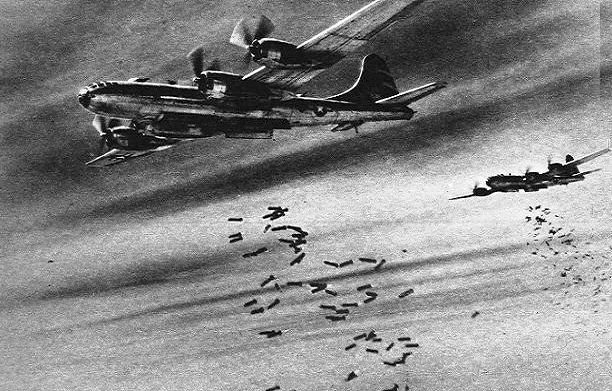 Bombs Over Burma
Bombs Over BurmaThis remarkable photo of three Superfortresses (note one in lower center) salvoing their bombs over a Rangoon target was taken by a member of the XX Bomber Command's Combat Camera Unit. B-29s of Brig. Gen. Roger M. Ramey's Command hit Rangoon the middle of February, their third attack against the Japanese's Burma stronghold. |
General Smith Presents Photo at . . . . .
Tata Services Club Formal Dedication
By SUPER-FORT Writer
JAMSHEDPUR, INDIA - British-American unity was knotted more tightly here recently with the formal dedication of the Tata Service Club, a leave and recreational center open to personnel of all Allied nations.
The Club, housed in a typical Indian building surrounded by spacious lawns and beautiful flower beds, owes its existence to the joint efforts of the Tata Iron and Steel Works and the American and British military authorities.
Attended by more than one hundred guests, the dedication program was complete with afternoon "tea," speeches, an evening play and a dance.
Brig. Gen. Joseph Smith, Chief of Staff of the XX Bomber Command, represented the American Army and presented a large tinted photograph (a line of coolies passing in front of a B-29) to the club. His short dedication speech was as follows:
"The dedication of the Tata Service Club represents much more than the mere acknowledgement of the opening of another Allied hostel. Obviously, it is a commendable achievement of similar purpose. Though not as spectacular as a joint military operation, it shows the cultural solidarity of peoples who not only are joined in bringing defeat to a common enemy, but who are devoted to a common way of life.
"On behalf of all the American Forces in this area, it is with pleasure that I express our gratitude for being allowed to participate in the development of the Tata Service Club.
"It had been Gen. Stratemeyer's and Gen. Ramsey's desire to attend the dedication personally. Unfortunately, this was precluded. I convey their regrets.
"As a symbol of the B-29's resident mission in India, I have been asked by Gen. Ramsey and the officers and men of the XX Bomber Command to present this picture (of the Superfortress and coolies) to the Tata Services Club. Thank you."
The Club is complete with attractively furnished dormitories, a luxurious lounge which is provided with a stage and a spacious dance floor, a restaurant, a library, a gift shop and general store, barber shop, a large swimming pool, a verandah and garden cafe and a variety of games.
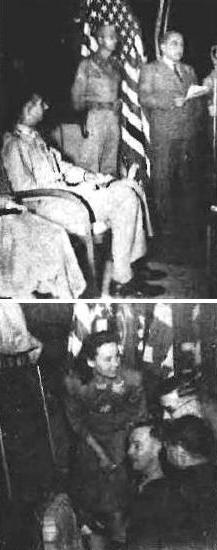
|
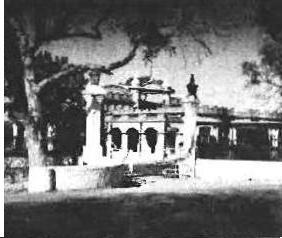
|

|
 Dry-dock Demolishers
Dry-dock DemolishersLargely responsible for the sinking of the huge floating dry-dock in Singapore harbor recently were these three pilot-navigator-bombardier load crew teams, all members of the XX Bomber Command group led by William H. Blanchard. They are (standing, left to right) Major Joseph V. McWilliams, pilot; Maj. Woodrow P. Swancutt, pilot; Maj. Marvin W. Goodwyn, pilot; Lt. Monroe Stein, navigator; Lt. Joe D. McGraw, bombardier; (Kneeling, left to right) Lt. Frank W. McKinney, bombardier; Capt. Donald Manfredo, navigator; Capt. Richard J. Seebach, bombardier, and Capt. Robert L. Swanson, navigator. The high altitude precision bombing by the Superfortress crews was hailed as one of the outstanding bombardment performances of the war. Loss of the huge dry-dock greatly weakened Japan's ship repairing facilities. |
Capt. Buenting Receives
Bronze Oak Leaf Cluster
A XX BOMBER COMMAND BASE, INDIA - For bringing his Superfortress and crew to safety through severe storms and savage enemy fighter attacks during an attack upon Japan, Capt. Otto W. Buenting, pilot, has been awarded a Bronze Oak Leaf Cluster in lieu of a second Distinguished Flying Cross. The citation reads:
"Prior to reaching the target at Omura, Japan, last November 21, Capt. Buenting's aircraft experienced a malfunction and it was necessary to jettison the bomb load. Capt. Buenting elected to attempt to pilot his aircraft to a friendly base rather than ditch the aircraft, due to the prevailing rough area.
"The bomber was depressurized and all loose equipment was thrown out. It was then that the plane came under severe and savage enemy fighter attacks in a 25-minute aerial battle. Whenever possible, Capt. Buenting, with extraordinary skill, turned into the attackers.
"As a result of this fighter attack, the bomber suffered damage to the hydraulic and oxygen systems and to the metal frame. In spite of this damage, Capt. Buenting landed his aircraft on a friendly field in China thereby saving the lives of his crew members and his valuable aircraft."
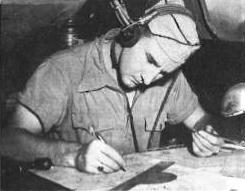 The Navigator is a key-man on the giant bomber, for it's his responsibility to get the ship - and its crew - to the
target and back. The B-29 is equipped with many gadgets which tend to simplify navigation.
The Navigator is a key-man on the giant bomber, for it's his responsibility to get the ship - and its crew - to the
target and back. The B-29 is equipped with many gadgets which tend to simplify navigation.
 Piloting a Superfort is no easy job. Missions similar to those run by the XX Bomber Command keep the pilot and co-pilot
busy until the plane is safe on terra firma again.
Piloting a Superfort is no easy job. Missions similar to those run by the XX Bomber Command keep the pilot and co-pilot
busy until the plane is safe on terra firma again.
 The Side Gunner on a B-29 huddles close into his blister where he can get a full view of the surrounding sky.
The Side Gunner on a B-29 huddles close into his blister where he can get a full view of the surrounding sky.
|
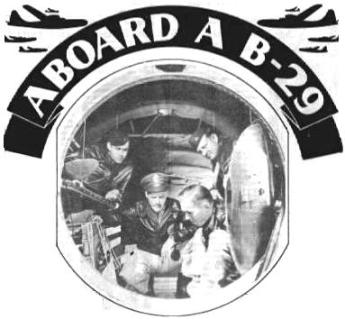
|
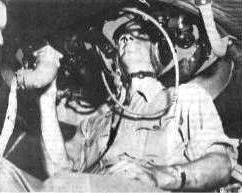 Seated on a revolving chair, the Center Gunner scans the sky for enemy fighters while the plane is
bound to and from the target area. His position increases with importance as the fighters close in.
Seated on a revolving chair, the Center Gunner scans the sky for enemy fighters while the plane is
bound to and from the target area. His position increases with importance as the fighters close in.
 One of three pressurized sections in this crew compartment, just aft of the gunners section in the
center of the plane. Bunks are provided for long missions.
One of three pressurized sections in this crew compartment, just aft of the gunners section in the
center of the plane. Bunks are provided for long missions.
 The radioman is an important person on a Superfort. His job is self-explanatory.
The radioman is an important person on a Superfort. His job is self-explanatory.
|
 An Ordnance Officer of the XXI Bomber Command attaches the finely-adjusted fusing mechanism to bombs
including incendiaries and fragmentation bombs - getting them ready for Tokyo in the cavernous jaw of a giant B-29.
An Ordnance Officer of the XXI Bomber Command attaches the finely-adjusted fusing mechanism to bombs
including incendiaries and fragmentation bombs - getting them ready for Tokyo in the cavernous jaw of a giant B-29.
|
 Amidst his delicate precision instruments, the Bombardier sits in the very nose of the Superfortress,
which has unusually steady flight performance to aid him in attaining accuracy.
Amidst his delicate precision instruments, the Bombardier sits in the very nose of the Superfortress,
which has unusually steady flight performance to aid him in attaining accuracy.
|
 Thirty-five feet long, this tunnel bypasses the unpressurized bomb bays and joins the pressurized
control cabin and the pressurized gunners' compartment. There are three pressurized and two unpressurized sections in
the large bomber.
Thirty-five feet long, this tunnel bypasses the unpressurized bomb bays and joins the pressurized
control cabin and the pressurized gunners' compartment. There are three pressurized and two unpressurized sections in
the large bomber.
|
 A long distance away from the pilot and bombardier, the Tail Gunner is the protectorate of the
rear end. His job gets mighty hot at times.
A long distance away from the pilot and bombardier, the Tail Gunner is the protectorate of the
rear end. His job gets mighty hot at times.
|

|
'Air Force' Gives B-29s Big Play
Air Force, the official service journal of the U.S. Army Air Forces, devoted more than four full pages to the Superforts of the XX and XXI Bomber Commands in its February issue. In an article, "Pioneers of the 'Double-X'," Air Force related the story behind the initial long-range bombings of Japanese occupied territory.
The magazine also printed a full page of pictures on the Japanese bombing, November 27, 1944, of Saipan, from where the XXI Bomber Command has been raining damage on the Nips' homeland. A double truk, two full pages of sketching called "Round Trip to Tokyo" also appeared in the issue.
|
New Book Will Dramatize B-29
Three army personnel from AAF Headquarters in Washington have arrived here to gather material for an official Air Corps book on the XX Air Force. They are Capt. Jerome bahr and S/Sgt. Roland Gammon, writers, and Lt. bartlett Frost, artist and photographer.
The three men, who are attached to the Washington Personnel Narratives Office under Col. Hans C. Adamson, are covering the XX Bomber Command bases in India and China, interviewing combat crews and group leaders, and gathering the human interest stories which will dramatize the development of the B-29 and the XX Air Force.
Before the war, Bahr was a New York short-story writer, Gammon a staff writer on Life Magazine, and Frost an artist in Springfield, Ill.
|
Wins Old Rank Back
S/Sgt. Hayton Bags 8 Jap Fighters
By SUPER-FORT Writer
APO 215 (Charra and Dudhkundi) - Superfortress gunner Richard V. Hayton is now a staff sergeant again, thanks to a lot of foolish Jap pilots and a publicity agent by the name of Cpl. Ralph Zahnizer.
The story of Hayton's fall and rise goes back several months, to a day when he failed to show up for a special assignment. S/Sgt. hayton, through the technical misunderstanding, was made a private.
Regardless of his efforts, special orders failed to list his name in the Private to Private First Class paragraph. Slightly exasperated and suffering from the financial reduction, Pvt. Hayton tried a new kind of bucking - against the Japs.
In a raid against Mukden, the Superfortress "411" ran into a little trouble. A Jap Nick slipped through the formation and blasted its number one engine. The crippled engine couldn't be feathered and "411" dropped from 24,000 to 6,000 feet. Jap fighter planes swarmed in for the kill - 30 to 35 strong. The interphone hummed like a party line as the gunners called out fighters a every hour of the clock.

|
Pvt. Hayton and all the other gunners went into immediate action, blazing the sky with burning lead. Jap planes swarmed in and about the hobbling Superfort. Many felt the wrath of American lead, caught fire and exploded. Scorched Nip pilots who reputedly don't carry parachutes, took to the silk.
More than an hour had passed and the B-29s guns still smoked and tracers gleamed as the "411" withstood the onslaught. Ammunition was running low when another Superfort came to the rescue and helped send the sons of heaven scampering for home. The battling bomber was finally landed.
A XX Bomber Command report revealed thirteen Jap fighters had been bagged in the running battle. Pvt. Hayton was credited with three enemy aircraft destroyed and five damaged. Eight Japs in little more than an hour.
Special Orders rewarded "Rearing Richard" by promoting him to a coveted Private First Class. Just recently, however, Pfc. Hayton was given a real boost. His former rank of staff sergeant was restored.
Thanks to the Japs and Cpl. Zahnizer, who wrote the first article about the exploits of the "411."

|
Air Depot Men Build Large Swimming Pool
By SUPER-FORT Writer
A XX BOMBER COMMAND BASE, INDIA - It takes plenty of guts to accomplish a project in the Army - especially when the "higher ups" believe it impossible and the damnable India elements show no consideration whatsoever.
And it was through plain guts, the determination of one officer and four enlisted men to do the "impossible," that the Air Depot here now boasts of the outstanding recreation facility in the Command:
A huge SWIMMING POOL.
Capable of handling several hundred soldiers, the pool - measuring 90 by 40 feet - is open from sunup until sundown. It is the most popular "off duty" facility on the base, is complete even to showers and a dressing room - all constructed with salvaged material.
More than six months in the making, the pool is a story of determination of reaching a goal that seemingly had no end. It's the story of Lt. Fred Nebera, athletic officer, Cpl. John Kuhar, Cpl. Orville Wilfong and Pfcs. James R. Ward and Roland W. Davis.
These men staged a continuous battle. They had to fight for permission to build the pool, for coolie labor to do the hand excavation, and above all, for material. "The idea of a pool was just a big joke," to those who could really help.
"The time came up when we almost called it quits to the whole deal. We had plenty of discouragements," said Lt. Nebera, "but the boys wanted to go on. We fought the extreme heat and rains. We even had to fight for salvage gravel which was the case of either putting it into good use, or letting the rains ruin it all."
An uphill battle all the way. The pool now stands as a symbol of perseverance.
 Re-Presents Trophy
Re-Presents TrophyCol. A. V. Jones, Commanding Officer, re-presents the large trophy won by members of the XX Bomber Command's Air Depot team recently at a local meet. Scoring 64 points, the Air Depot boys were 7 points better than the second-place Indian team. From left to right are: Cpl. Dave Smith, who placed second in the 120-yard high hurdles, fourth in the mile run; Col. Jones, Pfc. Lansceniese, fourth in javelin; S/Sgt. Ray Ekedal, first in the high hurdles, broad jump, pole vault and high jump; Cpl. Fred Mier, participant in the two mile cycle race; T/5 Chester Bickel, second in javelin, and Lt. Fred Nebera, third in javelin. |
 Enter Net Meet
Enter Net MeetAmong the members of the XX Bomber Command entered in the All-American Tennis Tournament at Calcutta March 19 are Lt. Herbert Maranz, left, and Capt. Mervin Newberg. |
 "FASCINATING THE WAY THAT THING SWINGS FROM SIDE TO SIDE,
"FASCINATING THE WAY THAT THING SWINGS FROM SIDE TO SIDE,EH, MAC?" |

|

|

|

|
SUPER-FORT is published from news and pictures supplied by staff members, base correspondents, OWI and Army News Service, and Camp Newspaper Service. Reproduction of CNS credited matter prohibited without permission of Camp News Service, 205 E. 42nd St. NYC 7. Published semi-monthly by the Information-Education branch of Personnel Section and Special Service Section of the XX Bomber Command. (Articles and photos are solicited and should be sent to SUPER-FORT, XX Bomber Command, APO 493, I-B Theatre.)

NEWS PUBLICATION OF THE XX BOMBER COMMAND
|
"Not just the best trained soldier in the world, not just the best equipped
soldier in the world, but the BEST INFORMED soldier in the world." |
Original issue of SUPER-FORT shared by Earl and Diana (Duty) Ingram
Vol. 1 No. 5 • 5 March 1945
Copyright © 2007 Carl Warren Weidenburner
TOP OF PAGE PRINT THIS PAGE ABOUT THIS PAGE
E-MAIL YOUR COMMENTS SUPER-FORT BASE

 SMOKE OVER SINGAPORE
Smoke pierced the fleece-lined clouds above Singapore and billowed for more than 20,000 feet when Superfortresses
of the XX Bomber Command continued to blast the Japanese-held installation. Taken from inside the nose of an approaching B-29, this remarkable photograph shows the smoke column at a height of 10,000 feet. The Empire Dock area was virtually destroyed during the Feb. 24 mission.
SMOKE OVER SINGAPORE
Smoke pierced the fleece-lined clouds above Singapore and billowed for more than 20,000 feet when Superfortresses
of the XX Bomber Command continued to blast the Japanese-held installation. Taken from inside the nose of an approaching B-29, this remarkable photograph shows the smoke column at a height of 10,000 feet. The Empire Dock area was virtually destroyed during the Feb. 24 mission.
 Life-Saving Admiration
Maj. Donald W. Roberts has real admiration for the Last Resort, his Jap-defying Superfort which carried him safely through four heavy enemy fighter attacks within one month's time. The major was recently awarded the Silver Star for "gallantry in action."
Life-Saving Admiration
Maj. Donald W. Roberts has real admiration for the Last Resort, his Jap-defying Superfort which carried him safely through four heavy enemy fighter attacks within one month's time. The major was recently awarded the Silver Star for "gallantry in action."
 Crew Chiefs Decorated
Crew Chiefs Decorated


 "Nice Girl"
"Nice Girl"

 NCO Club Burns
NCO Club Burns
 New Swimming Pool
New Swimming Pool